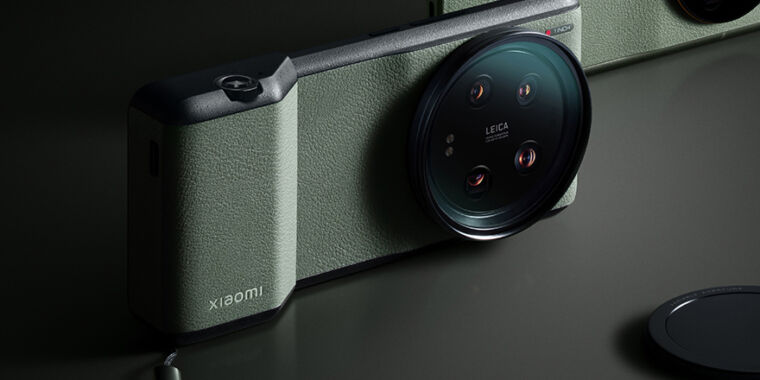The 13 Ultra is Xiaomi’s newest top-of-the-line smartphone, and it aims to have the best camera of any smartphone. There is a big 1-inch sensor, a lens with two apertures, and an extra camera grip with a shutter button. With its fake camera leather back and big, round camera bump, this looks almost like a point-and-shoot camera if you squint.
The most important thing is the 50 MP camera, which is driven by a 1-inch Sony IMX989 sensor. We’ve heard about this sensor before as the biggest and most powerful one on the market, in phones like the non-Ultra Xiaomi 13, the Vivo X90 Pro Plus, the Sharp Aquos R7, and the Leitz Phone 2, which is a rebranded version of the Sharp phone.
Xiaomi uses Sony’s big camera and adds a feature that hasn’t been seen since the Samsung Galaxy S9: a lens with two openings. In 2018, Samsung’s lens with two apertures could switch between f1.5 and f2.4. Even though that is interesting, there wasn’t enough room to do much with it.
A smaller aperture on a real camera is meant to do two things: 1) let in less light if the scene is too bright, and 2) make the depth of field bigger so that more things are in focus. None of that works for a camera on a phone. First of all, the small lenses can never get enough light, so a smaller aperture is usually bad for your pictures. Second, the focal length of smartphone photos isn’t big enough to do much with depth-of-field effects.
There’s a reason why professional camera lenses come in big cases. This doesn’t really work on a smartphone. Smartphones get around this problem with a lot of software effects, but none of them are real. The barely noticeable aperture change on the Galaxy S9 made your photos just a little bit darker and ugly, so it was taken out of phones that came after.
Xiaomi‘s dual lens can switch between f1.9 and f4.0, which is a bit more than what Samsung can do. The way the iris works is the same as Samsung’s. There are two blades: one is shaped like a C, and the other is smaller and makes a circle.
For a DSLR, a mechanical 12-blade iris gives you a changeable aperture that you can change to any exact degree you want, from f1.4 to f22 and every tiny step in between. These two-blade irises only have two settings: “open” (f1.9) with the blades retracted and out of the way of the camera lens, and “closed” (f4.0) with the blades stretched to make a smaller circle.
Like on the Samsung phone, the physics don’t work all the way here, so we wouldn’t expect the tech to do much for us. There will be plenty of depth-of-field effects in software, though.
There are four lenses on the back of the camera. The other three have Sony IMX858 1/2.51-inch cameras with 50MP. There is an ultrawide lens, a 3.2x telephoto lens, and a 5x telephoto lens. I don’t know why there are two long-range lenses.
When you put all of this camera gear into a phone, you get an interesting design called a “camera bump.” At about the middle of the phone, where the body starts to get bigger and stick out past the metal frame, Xiaomi’s phone starts to make room for the cameras.
The black, round bump for the camera is on top of the bigger body, making the phone look like it has a big difference in thickness all over. Xiaomi only lists the phone’s depth as 9.06 mm, which we’ll assume is the thinnest part of the phone. However, depending on where you measure, you could actually get three different depth readings.
Xiaomi has a “Professional Camera Bundle” for RMB 799, or about $116, which looks like a pretty good deal if you’re serious about taking photos with your small smartphone. This has two parts. First, it’s a phone case with a 67 mm adapter ring that goes around the camera bump.
You can screw on standard-size lens filters like a circle polarizer or neutral density filter, or you can use the lens cap that comes with the camera. The grip part gives you a big handle to hold onto and has a real two-stage shutter button, a rotating point-and-shoot-style zoom switch, and a lanyard.
Most camera grips also have a place for the battery, which means you get an extra 330 mAh. This is because the battery has a tiny bit of lithium-ion in it. The LG G5 flexible disaster phone was the first to do this. LG’s camera grip had a battery with 1200 mAh.
Under all of the camera functions is a normal top-of-the-line smartphone from 2023. A 6.73-inch, 120 Hz, 32001440 OLED screen, a Snapdragon 8 Gen 2 SoC, 12GB of RAM, 256GB of storage, and a 5000 mAh battery. With a 90 W regular charger and a 50 W wireless charger, Xiaomi’s charging tech sounds great.
Read More:
Email App Updates Incorporating ChatGPT Technology Are Halted by Apple.











